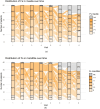Oral health in adolescents: periodontal inflammatory biomarkers during orthodontic clear aligner therapy
- PMID: 40042542
- PMCID: PMC11882737
- DOI: 10.1007/s00784-025-06212-9
Oral health in adolescents: periodontal inflammatory biomarkers during orthodontic clear aligner therapy
Abstract
Objectives: This prospective study aimed to evaluate periodontal inflammation in adolescents undergoing orthodontic treatment with clear aligners (Invisalign® Teen, Align Technology, San Jose, CA, USA). Key objectives included assessing the presence of 11 periodontitis-associated marker bacteria, active matrix metalloproteinase-8 concentrations in sulcular fluid, and the influence of IL-1 polymorphism genotypes on periodontal health.
Materials and methods: Fifty adolescent patients (13.3 ± 1.8 years) with mixed and permanent dentition participated. Gingival crevicular fluid samples were analyzed at multiple time points: before, during, and one year after aligner treatment. Periodontal health was assessed using the Gingivitis Index and the Modified Quigley-Hein Index. Genotypic analysis of IL-1 polymorphism was also performed. Statistical analyses included mixed linear models and generalized linear models to explore correlations.
Results: All combinations of IL-1 polymorphism genotypes were found in the sample. No significant increase in periodontal inflammation or aMMP-8 concentrations was observed over the treatment period. Marker bacteria from the red and orange-associated complexes remained at low levels, while significant changes occurred in the orange and green complexes, particularly Capnocytophaga spp. (p = 0.0042) and Fusobacterium spp. (p = 0.0365). GI correlated significantly with aMMP-8 levels (p = 0.0017), but no genotype effect on GI was observed. MQH showed associations with pathogens from the orange and green complexes, including Capnocytophaga spp. and Fusobacterium spp.
Conclusions: Clear aligner treatment in adolescents, including those with an unfavorable genotype, does not increase periodontal inflammation when accompanied by good oral hygiene.
Clinical relevance: Regular periodontal monitoring and hygiene reinforcement is important during orthodontic treatment, especially in adolescent patients.
Keywords: Aligner therapy; IL-1 polymorphism; Inflammatory biomarker; Matrix metalloproteinase-8; Orthodontics.
© 2025. The Author(s).
Conflict of interest statement
Declarations. Ethics approval: The study was conducted in accordance with the Declaration of Helsinki, and approved by the Ethics Committee of the Medical Chamber of Rhineland Palatinate (9565; 2014.08.20). Informed consent: Informed consent was obtained from all subjects involved in the study. Competing interests: The authors declare no competing interests.
Figures








References
-
- Christensen GJ (2002) Orthodontics and the general practitioner. J Am Dent Assoc 133:369–71. 10.14219/jada.archive.2002.0178 - PubMed
-
- Tuncay O, Bowman SJ, Amy B, Nicozisis J (2013) Aligner treatment in the teenage patient. J Clin Orthod 47:115–9; quiz 140 - PubMed
-
- Abbate GM, Caria MP, Montanari P, Mannu C, Orru G, Caprioglio A, Levrini L (2015) Periodontal health in teenagers treated with removable aligners and fixed orthodontic appliances. J Orofac Orthop 76:240–250. 10.1007/s00056-015-0285-5 - PubMed
-
- Miethke RR, Vogt S (2005) A comparison of the periodontal health of patients during treatment with the Invisalign system and with fixed orthodontic appliances. J Orofac Orthop 66:219–229. 10.1007/s00056-005-0436-1 - PubMed
MeSH terms
Substances
LinkOut - more resources
Full Text Sources
Medical
Miscellaneous

